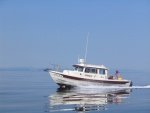cgypsy
New member
- Joined
- Mar 2, 2015
- Messages
- 181
- Reaction score
- 0
- C Dory Year
- 1999
- C Dory Model
- 22 Cruiser
- Vessel Name
- C Gypsy
I have just purchased a 22' Cruiser with twin Honda 50a and will be enjoying doing some cruising this summer.
However, my first challenge is to resolve a steering issue.
In general the steering is a little bit stiff, but when you turn the wheel all the way to the left, if feels like the wheel gets stuck there and it takes a lot of effort to bring it back to the centre. It is fine when I turn to the left.
The previous owner had a mechanic look at it and they cleaned the cable and replaced some steering bearings in one of the motors.
When the motors are turned off or the boat is at idle, the steering feels perfectly fine (which probably why the mechanic thought it was fixed) however when going at planing speed, the steering is very stiff to the left. It is a little stiff when I turn to the left, but it is ever more stiff when I try to turn back to centre.
Any suggestions?
However, my first challenge is to resolve a steering issue.
In general the steering is a little bit stiff, but when you turn the wheel all the way to the left, if feels like the wheel gets stuck there and it takes a lot of effort to bring it back to the centre. It is fine when I turn to the left.
The previous owner had a mechanic look at it and they cleaned the cable and replaced some steering bearings in one of the motors.
When the motors are turned off or the boat is at idle, the steering feels perfectly fine (which probably why the mechanic thought it was fixed) however when going at planing speed, the steering is very stiff to the left. It is a little stiff when I turn to the left, but it is ever more stiff when I try to turn back to centre.
Any suggestions?

